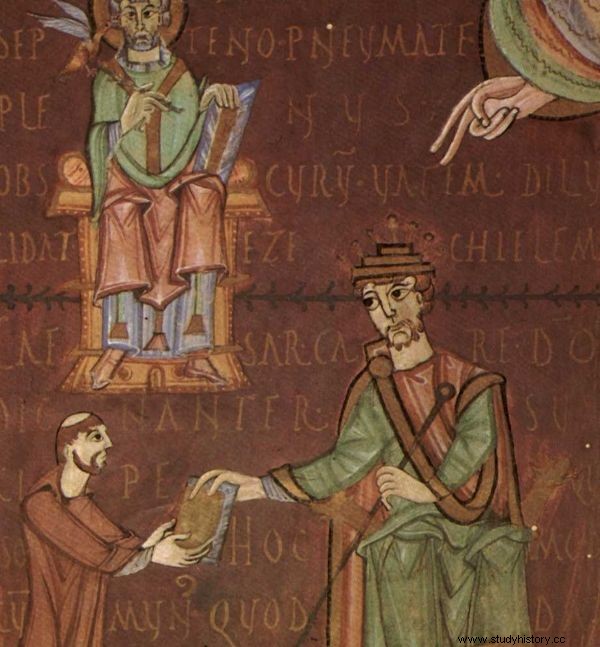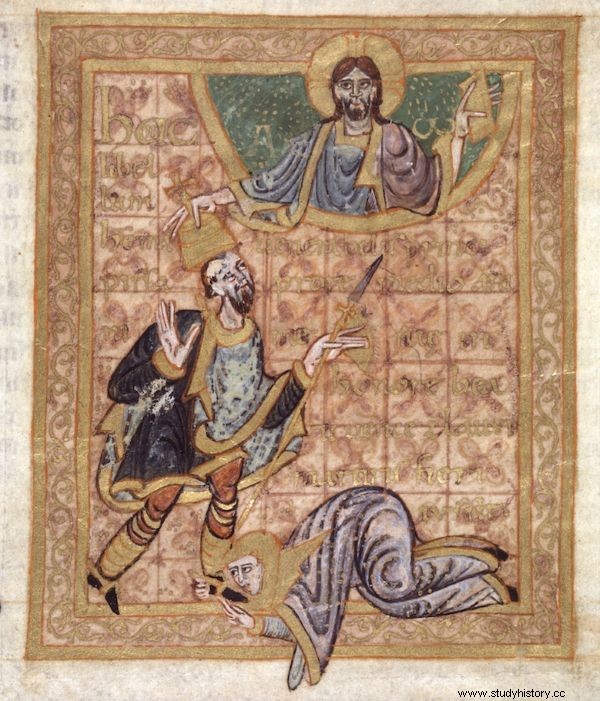Barely Chrobry took full power from his father, and he was already face to face with a gang of thugs armed to the teeth. Only a miracle saved the skin. He never found out who the architect of the plot was. After a thousand years, it's time to know the answer.
It was August 1002 and the Polish prince Bolesław was in Merseburg. Recently, Emperor Otto III, allied with him, died unexpectedly. He was less than twenty-two years old. However, he had neither wife nor children.
As usual in such cases there was a political turmoil and civil war. Only after a few months, the Prince of Bavaria, Henry, the son of Henryk Kłótnik, a brawler and coward, who was too well known to the Piasts, sat on the German throne. The man who twice involved Mieszko I in civil wars in Germany. Each time with disastrous results.
The new king was not an idealist or a naive. He was nothing like the young and inexperienced Otto III. His father's, too. He practiced Realpolitik in its purest form, and he disliked Prince Bolesław deeply. Nevertheless, he met with him in Merseburg, trying to establish a favorable relationship with his eastern neighbor. The Polish ruler left the convention with rich gifts and a smile on his face.
The latter, however, disappeared immediately, giving way to a grimace of surprise. Maybe even fear.

Returning from the meeting in Merseburg, Bolesław did not expect an attack. Couldn't expect.
The prince takes his feet by the belt
Bolesław traveled with a small retinue. It was not proper to go to negotiations with a real army, and besides, within the borders of Germany, security was guaranteed by his host, i.e. King Henry II. There was apparently nothing to worry about.
The cavalcade was heading towards the gates of the city, the warriors were joyful and relaxed. Unexpectedly, almost in the vicinity of the palace, their path was blocked by a group of men armed to the teeth. These were not the king's sentries or soldiers. But there was a swarm of them, and without a word they rushed to attack. Before Bolesław noticed, the slaughter had begun.
Many soldiers accompanying Piast were killed. He himself hastily estimated the chances and started to flee. He saved his skin by a fortunate twist of fate. He was escorted by the well-known Merseburg Bawar, Henryk of Schweinfurt. At the moment of danger, he immediately showed the way to another gate, which was breached without further ado. The prince was safe.

To this day, historians hold King Henry II responsible for the attack. Not necessarily right.
Unknown Perpetrators
The perpetrators of the attempt on his life have never been discovered. The prevailing view among historians is that the attack was ordered by King Henry. However, such an explanation is questionable.
The new German ruler never feared controversial and risky decisions. But he had a head on the back of his neck. When organizing the attack in Merseburg itself, he had to take into account that he would be accused.
It was in the king's interest to attack a lonely forest road that could easily be blamed on the pagan Slavs. There are other known conspiracies, the (supposed) initiator of which was Henry. And it must be emphasized that each time he subtly obliterated his traces or blamed the placed figureheads.
A bomber with experience
Even when his only serious competitor to power, Prince Ekkehard, the Bavarian died in a brutal and dishonorable murder, he played the case so that officially no one could suspect him of anything. On the other hand, he made the whole top of the state tremble at the mere thought of throwing the glove at him.
Also in a conflict with Bolesław, Henryk would be capable of much more cunning and thoughtful actions. The stupid swing just wasn't his style. Anyway - there was no attempt on Piast, because in 1002 there was no reason to kill Bolesław.
The Polish ruler was a certain nuisance for King Henry. But certainly not a deadly enemy that must be eliminated at all costs. Not yet.

A seasoned politician and a ruthless ruler. This is what Henry II was like. Here on a miniature from the 11th century.
The blame is the one who benefited
There is an alternative explanation. If the attack was commissioned by a completely different person, Merseburg should even appear to her as an ideal location. And that's because the king had to be the prime suspect at this point.
An old Roman saying says:the profit is guilty. Meanwhile, it is not difficult to indicate who would gain the most from the premature death of Bolesław. Above all, Oda and her sons dreamed of his death.
Mieszko's second wife had a few years of brutal civil war with her stepson behind her. There are many indications that in the course of the conflict, Bolesław used the most brutal and ruthless measures to unite the country in his hands. With the help of his wife, Emnilda, he attacked his stepmother's immediate family.
He led to the imprisonment of her birth sister, Matilda. And when Oda did not agree to unconditional surrender anyway - he ordered the prisoner's husband to be killed and probably threatened that Matilda herself would be next. Only this prompted Oda to leave the country. But anger still burned in her heart.

For years, Oda ruled Poland together with her husband. She did not intend to give up power only because Mieszko had died. Above is an illustration from the German "Manesee Code".
The preserved sources suggest that Oda barely crossed the border of Germany, and she forgot about her vendetta and said goodbye to the lust for power. Everything that is known about her previous rule and her unbridled ambition makes one doubt sincerely that she has remained completely inactive. Hurry up - she was waiting for the perfect moment to attack. It just happened in 1002.
A born heir
Oda's eldest son, Mieszko, banished with her, was already an adult man, ready to assume the duties of a leader and even a ruler.
Admittedly, Bolesław had his own descendants, but his departure from the stage would allow the reopening of a war for power. This time, Oda would only be against a young widow and a twelve-year-old young man, Mieszko Lambert. She no doubt believed that such a fight could not be lost.

Learn about the fascinating history of women who built Poland in the darkness of the Middle Ages. Ruthless, ambitious, talented. Kamil Janicki's "Iron Ladies" is now on sale !
Anyway - examples from neighboring countries show that she was driven by cold calculation and not only a desire for revenge.
Oda's return to Poland after Bolesław's death was very likely. In the Czech Republic, where similar events took place, the courtiers did in fact recall the old queen and her sons from exile as soon as political conditions changed.
It was happening more or less at the same time and there was also some bloodshed there.

Bohemian Duchess Emma. After her husband's death, she found herself in a very similar situation to Oda in Poland.
The last hand
Oda, however, was much less fortunate than her Czech friend, Princess Emma. The assassins failed, and nothing was heard of any further attempts to take Bolesław's life.
If someone unraveled the mystery of the attack, it was probably only King Henry II, who had a network of spies and informers. Oda's actions certainly did not fill him with joy, since his own reputation had suffered in the first place. The whole continent believed that he had taken Piast's life.
The ruler's disappointment and distrust towards the deposed Polish duchess would explain why he deleted her from the repertoire of his political means forever. He did not use the margrave in conflicts with Bolesław and did not try to win anything from her misfortune. Oda's historical role has run out.

If Oda had been successful, today hardly anyone would have remembered about Bolesław the Brave. And certainly no monuments would be erected for him.
***
What happened a thousand years ago? Was it the baptism of Poland or of just one man? What was the role of the princely spouse, what was the ruthless father-in-law, and what - sincere faith? You will learn the answers to these questions in the book by Kamil Janicki "Iron Ladies. The Women Who Built Poland ” . Don't miss one of the greatest historical bestsellers of recent years! Click HERE to purchase your own copy.
Sources:
The article is based on the literature and materials collected by the author during the work on the book "Iron Ladies. The Women Who Built Poland ” . Find out more by clicking HERE .
- Grabski A.F., Bolesław Chrobry 967-1025 , Warsaw 1970.
- Korta W., Milsko and Łużyce in the politics of the first Piasts , "Sobótka", vol. 2 (1990).
- Matla-Kozłowska M., The Beginnings of States. Czech Republic , Poznań 2014.
- Pleszczyński A., Germany towards the first Piast monarchy (963–1034). The birth of the stereotype , Lublin 2008.
- Pleszczyński A., The beginning of the rule of Bolesław the Brave [in:] Viae historicae. Jubilee book dedicated to Professor Lech A. Tyszkiewicz on the seventieth anniversary of his birth , Wrocław 2001.
- Sikorski D.A. , The Church in Poland of Mieszko I and Bolesław the Brave. Considerations on the Limits of Historical Cognition , Poznań 2013.
- Strzelczyk J., Bolesław the Brave , Warsaw 2014.
- Thietmar, The Chronicle of Thietmar , transl. M.Z. Jedlicki, Krakow 2012.
- Wiszewski P., Domus Bolezlai. In search of the Piast dynastic tradition (until around 1138) , Wrocław 2008.
- Wojciechowski Z., Patriciate of Bolesław the Brave , "Annals of History", vol. 18 (1949).
- Zakrzewski S., Bolesław the Brave , Lviv 1925.
